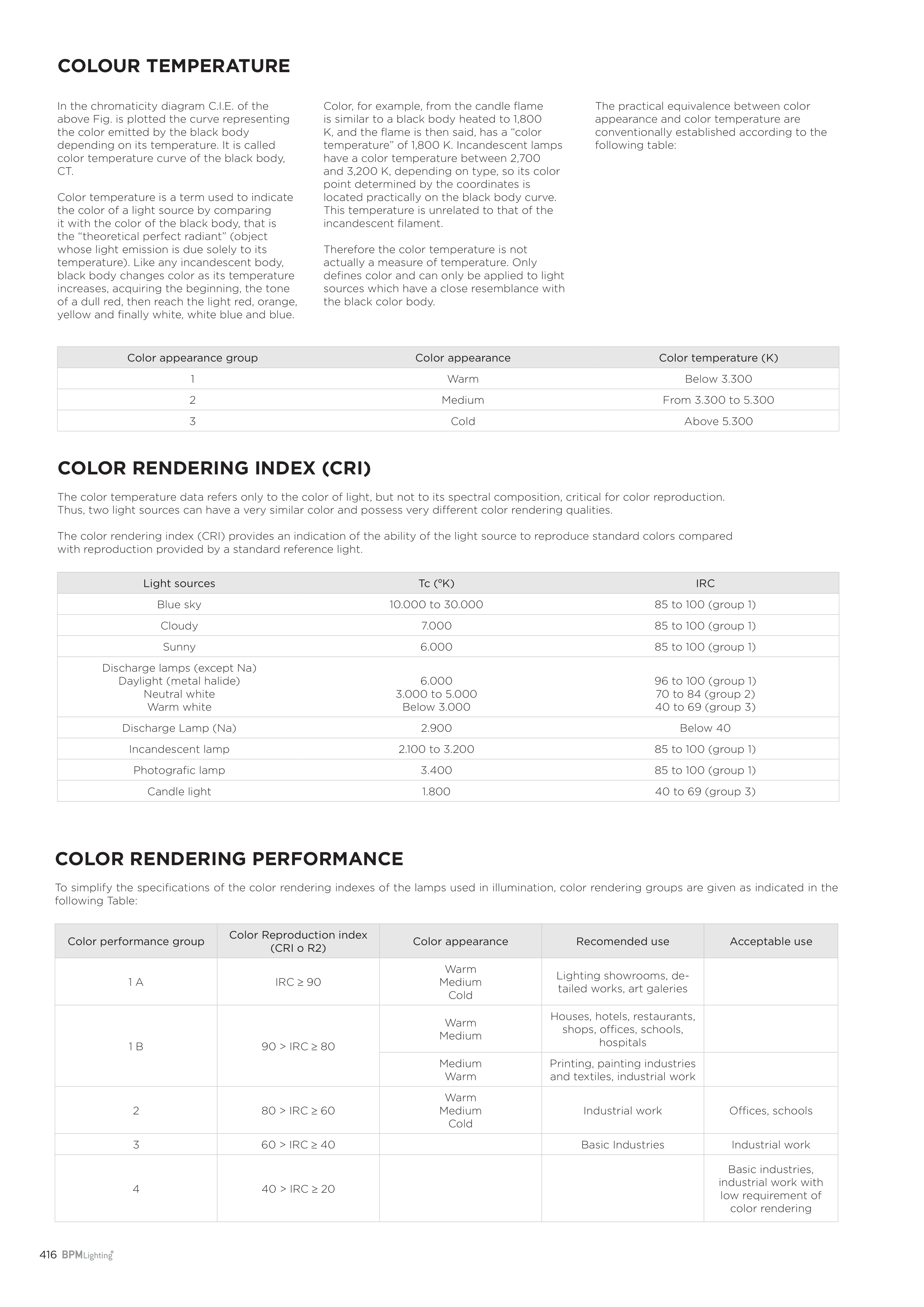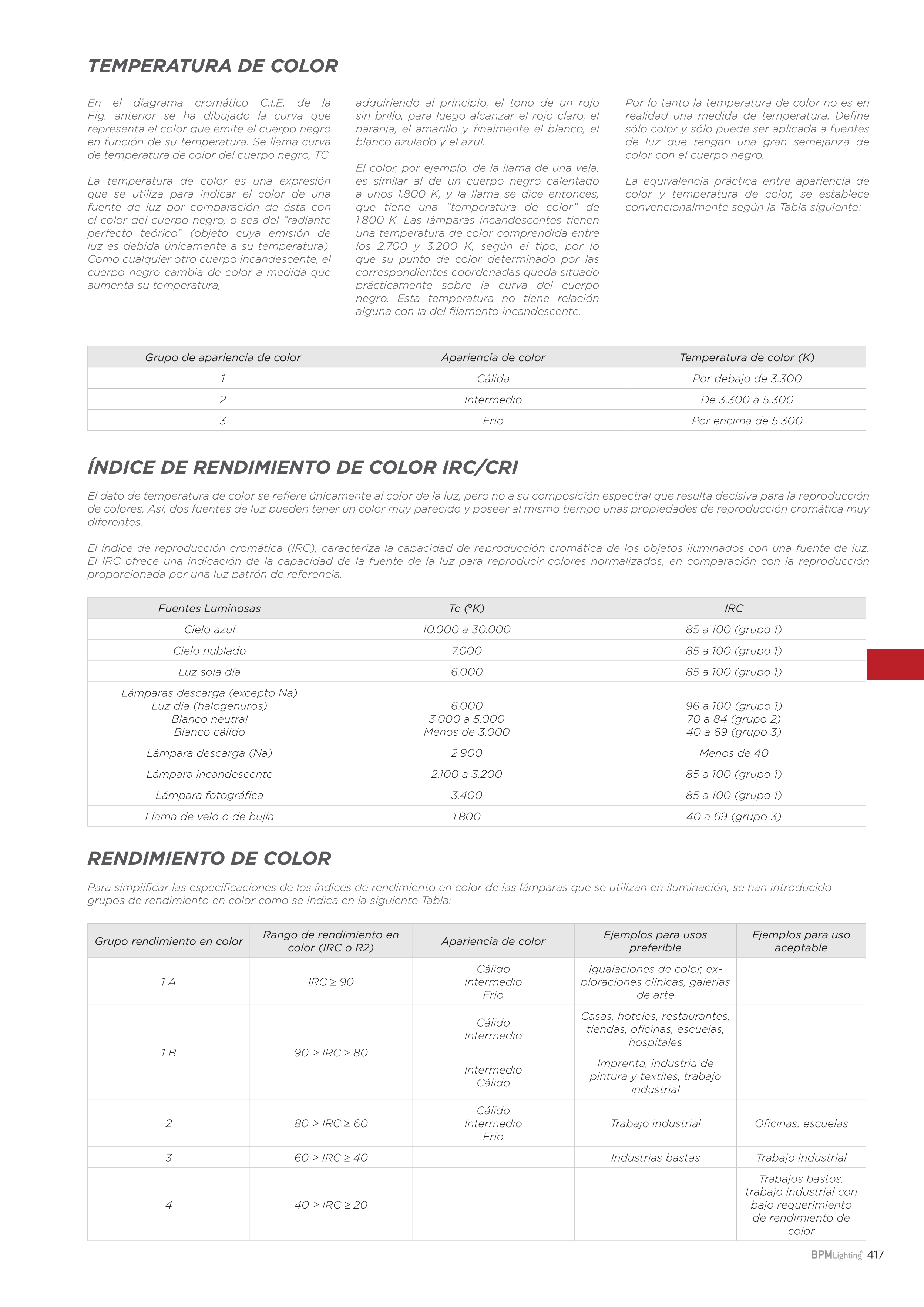416
COLOR RENDERING INDEX (CRI)
The color temperature data refers only to the color of light, but not to its spectral composition, critical for color reproduction.
Thus, two light sources can have a very similar color and possess very different color rendering qualities.
The color rendering index (CRI) provides an indication of the ability of the light source to reproduce standard colors compared
with reproduction provided by a standard reference light.
Light sources
Tc (ºK)
IRC
Blue sky
10.000 to 30.000
85 to 100 (group 1)
Cloudy
7.000
85 to 100 (group 1)
Sunny
6.000
85 to 100 (group 1)
Discharge lamps (except Na)
Daylight (metal halide)
Neutral white
Warm white
6.000
3.000 to 5.000
Below 3.000
96 to 100 (group 1)
70 to 84 (group 2)
40 to 69 (group 3)
Discharge Lamp (Na)
2.900
Below 40
Incandescent lamp
2.100 to 3.200
85 to 100 (group 1)
Photografic lamp
3.400
85 to 100 (group 1)
Candle light
1.800
40 to 69 (group 3)
COLOR RENDERING PERFORMANCE
To simplify the specifications of the color rendering indexes of the lamps used in illumination, color rendering groups are given as indicated in the
following Table:
Color performance group
Color Reproduction index
(CRI o R2)
Color appearance
Recomended use
Acceptable use
1 A
IRC ≥ 90
Warm
Medium
Cold
Lighting showrooms, de-
tailed works, art galeries
1 B
90 > IRC ≥ 80
Warm
Medium
Houses, hotels, restaurants,
shops, offices, schools,
hospitals
Medium
Warm
Printing, painting industries
and textiles, industrial work
2
80 > IRC ≥ 60
Warm
Medium
Cold
Industrial work
Offices, schools
3
60 > IRC ≥ 40
Basic Industries
Industrial work
4
40 > IRC ≥ 20
Basic industries,
industrial work with
low requirement of
color rendering
In the chromaticity diagram C.I.E. of the
above Fig. is plotted the curve representing
the color emitted by the black body
depending on its temperature. It is called
color temperature curve of the black body,
CT.
Color temperature is a term used to indicate
the color of a light source by comparing
it with the color of the black body, that is
the “theoretical perfect radiant” (object
whose light emission is due solely to its
temperature). Like any incandescent body,
black body changes color as its temperature
increases, acquiring the beginning, the tone
of a dull red, then reach the light red, orange,
yellow and finally white, white blue and blue.
Color, for example, from the candle flame
is similar to a black body heated to 1,800
K, and the flame is then said, has a “color
temperature” of 1,800 K. Incandescent lamps
have a color temperature between 2,700
and 3,200 K, depending on type, so its color
point determined by the coordinates is
located practically on the black body curve.
This temperature is unrelated to that of the
incandescent filament.
Therefore the color temperature is not
actually a measure of temperature. Only
defines color and can only be applied to light
sources which have a close resemblance with
the black color body.
The practical equivalence between color
appearance and color temperature are
conventionally established according to the
following table:
COLOUR TEMPERATURE
Color appearance group
Color appearance
Color temperature (K)
1
Warm
Below 3.300
2
Medium
From 3.300 to 5.300
3
Cold
Above 5.300



